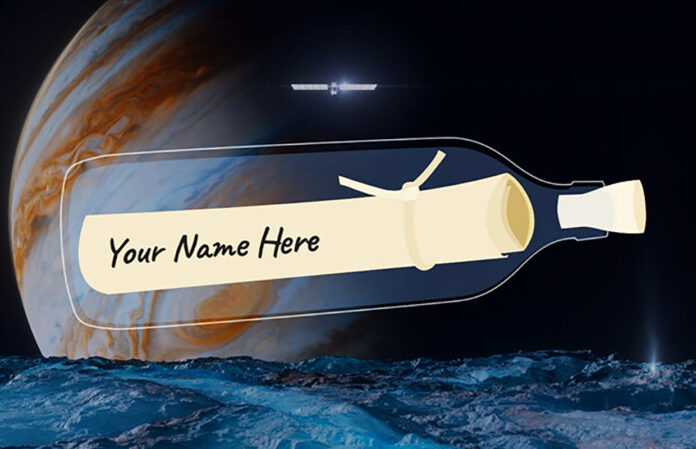WASHINGTON — The public is invited to add their names to an original poem dedicated to NASA’s Europa Clipper mission before the spacecraft begins its journey to Jupiter’s moon Europa in October 2024.
The Planetary Missions Program Office at NASA’s Marshall Space Flight Center executes program management of the Europa Clipper mission.
The poem and the names will be like a “Message in a Bottle,” traveling millions of miles as the mission investigates whether the ocean beneath Europa’s icy crust could support life.
“‘Message in a Bottle’ is the perfect convergence of science, art, and technology, and we are excited to share with the world the opportunity to be a part of Europa Clipper’s journey,” said Nicola Fox, associate administrator for NASA’s Science Mission Directorate in Washington. “I just love the thought that our names will be traveling across our solar system aboard the radiation-tolerant spacecraft that seeks to unlock the secrets of Jupiter’s frozen moon.”
The “Message in a Bottle” campaign offers the opportunity to have their name stenciled onto a microchip bearing U.S. Poet Laureate Ada Limón’s “In Praise of Mystery: A Poem for Europa.” The chip will ride aboard NASA’s Europa Clipper.
Names must be received before 11:59 p.m. EST, Dec. 31. Click here to sign, read the poem, and hear Limón recite the poem in an animated video.
Participants can create and download a customizable souvenir – an illustration of your name on a message in a bottle against a rendering of Europa and Jupiter. Participants are encouraged to share on social media using the hashtag #SendYourName.
The “Message in a Bottle” campaign is similar to other NASA projects that have enabled people to send their names to ride along with Artemis I and several Mars spacecraft. It draws from the agency’s long tradition of shipping inspirational messages on spacecraft that have explored our solar system and beyond.
In the vein of NASA’s Voyagers’ Golden Record, which sent a time capsule of sounds and images to communicate the diversity of life and culture on Earth, the program aims to spark the imagination of people around the world.
“Inspiration is what fueled the people who developed this flagship mission and who hand-crafted the largest spacecraft NASA has sent to explore the solar system,” said Laurie Leshin, director of NASA’s Jet Propulsion Laboratory in Southern California. “It’s what drives humanity to ask the big questions that this mission will contribute to, which leads the development of Europa Clipper.
“Inspiration is riding along with every single name that will be making the journey to Europa.”
Europa Clipper currently is being assembled, on camera, at JPL.
Set to launch from Cape Canaveral, the spacecraft will travel 1.8 billion miles to reach the Jupiter system, where it will arrive in 2030.
As it orbits Jupiter and flies by Europa about 50 times, it will log another half-billion miles while a suite of science instruments gathers data on the subsurface ocean, the ice crust, and the moon’s atmosphere.
In January, Limón visited JPL to see the spacecraft and learn more about the mission.
She was appointed 24th Poet Laureate Consultant in Poetry by Librarian of Congress Carla Hayden in 2022 and reappointed for a second, two-year term in April 2023.
Limón was born in Sonoma, California, and is of Mexican ancestry. She is the author of several poetry collections, including “The Hurting Kind” and “The Carrying,” which won the National Book Critics Circle Award for Poetry.
Europa Clipper’s main science goal is to determine whether there are places below the surface of Europa that could support life. The mission’s three main science objectives are to understand the nature of the ice shell and the ocean beneath it, along with the moon’s composition and geology. The mission’s detailed exploration of Europa will help scientists better understand the astrobiological potential for habitable worlds beyond our planet.
Managed by Caltech in Pasadena, California, JPL leads the development of the Europa Clipper mission in partnership with the Johns Hopkins Applied Physics Laboratory in Laurel, Maryland, for NASA’s Science Mission Directorate in Washington.
APL designed the main spacecraft body in collaboration with JPL and NASA’s Goddard Space Flight Center in Greenbelt, Maryland.
Don’t miss out! Subscribe to our email newsletter to have all our smart stories delivered to your inbox.



